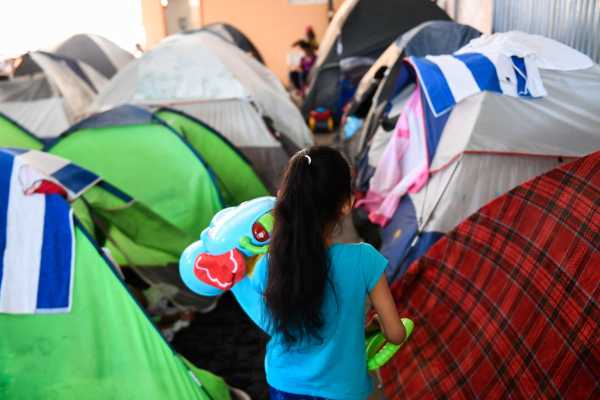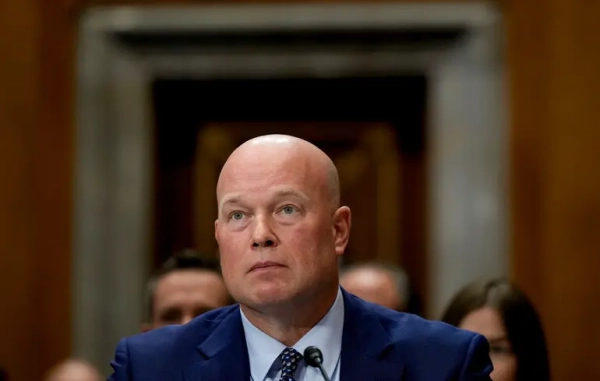
The Biden administration is proceeding with its plans to end Title 42, a policy implemented under then-President Donald Trump that has allowed the US to expel hundreds of thousands of migrants at the southern border under the guise of curbing the spread of Covid-19.
The policy that was put in place under a dubious public health rationale has become an overt, de facto national immigration and border security strategy. Title 42’s rollback is expected to prompt an increase in migration to the border that will challenge US immigration and border enforcement capabilities and could have huge political consequences for Biden and Democrats. Republicans are ready to pounce on the anticipated border surge that could come when it lifts, and some Democrats — including ones in tight reelection races in this fall’s midterms — are urging Biden to leave Title 42 in place for now.
The White House insists that Congress will have to intervene if it wants to delay the rollback past May 23, and Homeland Security Secretary Alejandro Mayorkas headed to Capitol Hill this week to discuss the administration’s plans to handle an influx of migrants. On Wednesday, Republicans threatened him with impeachment as he reiterated pleas for Congress to fix the broken system that the Biden administration inherited on the border and announced that officials are preparing to request supplemental funding to address a spike in arrivals.
But court challenges could also affect the plans, including a case in Louisiana federal court in which a judge is expected to imminently issue a ruling that could delay or prevent the wind-down.
Here’s what you need to know about the policy and the political fight over ending it.
Title 42, explained
Title 42 is a previously little-known section of US health law that allows the US government to temporarily block noncitizens from entering the US “when doing so is required in the interest of public health.” When the Trump administration invoked Title 42 in March 2020 at the outset of the pandemic, White House officials argued that it had been recommended by public health officials to prevent the spread of Covid-19 among migrants in crowded Border Patrol stations.
But public health officials weren’t the ones pushing the policy; the effort was led by Stephen Miller, a former senior adviser to Trump and the chief architect of his immigration policy, which focused on reducing overall immigration levels to the US, at times by deliberately cruel means. Even before the pandemic, Miller had been looking for opportunities to use Title 42 to expel migrants, including when there was a mumps outbreak in immigration detention and flu spread in Border Patrol stations in 2019.
The policy has effectively shut out migrants arriving at the southern border from legal pathways to enter the US (there are limited exceptions for some families, unaccompanied children, and Ukrainians). Before Title 42, the migrants would have been processed at Border Patrol facilities and evaluated for eligibility for asylum and other humanitarian protections that would allow them to remain in the US. Migrants have a legal right, enshrined in US and international law, to seek asylum. But under Title 42, migrants are returned to Mexico within a matter of hours and without any such opportunity.
The US has used Title 42 to expel migrants more than 1.8 million times since March 2020. Many have been caught trying to cross the border multiple times because the policy removed any potential adverse legal consequences of doing so.
The policy was controversial when Trump implemented it: It was clear that the primary purpose of the policy was not to protect public health, but to advance Trump’s political goal of cracking down on unauthorized immigration at great human cost.
The Biden administration has had plenty of opportunities to roll back Title 42, starting when Biden made a flurry of executive actions in January 2021 to roll back other Trump-era immigration policies. Because the administration waited more than a year to take action, it has had to affirmatively defend the policy as a necessary public health tool. And the current reality on the border, where most migrants are being turned away under Title 42, has become the new normal.
The Centers for Disease Control and Prevention found earlier this month that Title 42 was no longer necessary to protect public health from the spread of Covid-19. Many public health experts outside the agency argued all along that it was never necessary for public health because community transmission inside the US, not introduction of the virus from Mexico, is what has driven the spread of Covid-19 in the country. They say that the US always had the capacity to safely process migrants by means of testing, quarantining, and enforcing masking. But the Trump administration maintained that Title 42 was a means of mitigating “serious danger to migrants, our front-line agents and officers, and the American people,” as then-acting Homeland Security Secretary Chad Wolf said at a White House event announcing the policy.
Not only was Title 42 questionable from a public health standpoint, it didn’t deter migration. Before Title 42, migrants might have been subject to swift deportation proceedings, known as “expedited removal,” and criminal prosecution, which would have made it more difficult for them to get legal status in the US down the line. But now they’re simply returned to Mexico and undeterred from trying to cross again.
That’s reflected in the data: There were nearly twice as many border apprehensions in fiscal year 2021 as in fiscal year 2019. Before the pandemic, only 7 percent of people arrested at the border had crossed the border more than once; in fiscal year 2022, it’s 27 percent, and among single adult migrants from El Salvador, Guatemala, and Honduras specifically, it’s 49 percent.
What Title 42 has meant for migrants
Title 42, coupled with other Trump policies designed to keep out migrants, has impacted the lives of hundreds of thousands of migrants who are effectively trapped in Mexico, many living in shelters or camps along the border and relegated to informal work if they can find work at all. Many of them had nowhere else to go: Gang violence, climate-related challenges, and economic instability due to the pandemic are common factors in their decisions to flee their home countries.
Though Title 42 is still the US’s primary means of turning back migrants to Mexico, migrants have also been returned under the Trump administration policy colloquially known as “Remain in Mexico.” The Trump administration used this policy to send 70,000 asylum seekers to Mexico while they awaited their immigration court hearings in the US.
Biden tried to roll back Remain in Mexico last year, but a Trump-appointed judge ordered the administration to reinstate the program in December. The administration appealed that ruling to the US Supreme Court, which heard arguments in the case on Tuesday and will determine whether the rollback of Remain in Mexico can proceed. In the meantime, another 3,012 migrants — most from Cuba, Nicaragua, and Venezuela — have since been enrolled in the program under Biden.
Mexico is woefully ill-equipped to administer to the needs of thousands of migrants who have been waiting in border towns for a chance to enter the US. When migrant shelters are full, some have been forced into camps in cities such as Tapachula and Reynosa along Mexico’s southern and northern borders, where they rely on NGOs to provide basic supplies and services, including medical care. During the pandemic, social distancing in these environments has been difficult if not impossible, and access to testing and vaccines has been sparse.
What’s more, Title 42 and Remain in Mexico have endangered migrants by sending them back to Mexico. The refugee advocacy group Human Rights First documented 8,705 reports of kidnappings and other violent attacks against migrants sent back to Mexico by the US. Haitians and other Black migrants have been at particular risk because of the discrimination they face in Mexico.
What will happen when Title 42 is lifted?
Lifting Title 42 would be a seismic change in US policy for migrants who have been stranded in northern Mexico, in many cases for years. After May 23, families and single adults who are caught trying to cross the border will be processed and placed in deportation proceedings. They might be detained while fighting their deportation cases, a process that could take months or even years, or released while being monitored. If they can’t prove that they have a legal basis to stay in the US (such as asylum or other humanitarian protections), then they will be deported, which would also make it harder for them to legally immigrate in the future.
The policy change would bring challenges for Biden administration officials, who face the enormous task of safely and humanely processing what will likely be a sharp increase in the number of migrants arriving on the southern border in the coming months. DHS and State Department officials told reporters earlier this month that they are concerned that smugglers will contribute to that anticipated spike, misrepresenting the policy change to migrants and overstating their chances of getting legal status in the US.
The administration is preparing for a worst-case scenario of as many as 18,000 migrants arriving daily after Title 42 is lifted, up from an average of about 5,900 in February. Secretary Mayorkas told CBS earlier this week that the agency has been preparing for months for that kind of scenario and has already deployed additional resources to the border to deal with it, including hundreds of personnel, transportation, medical resources, and new soft-sided processing facilities.
“We are confident that we can implement our plans when they are needed. … [W]e are planning for different scenarios,” he said. But he also admitted that “certain of those scenarios present significant challenges for us.”
On Tuesday, Mayorkas issued a 20-page memo formalizing those plans, which include surging even more resources to the border, increasing processing efficiency, enforcing legal consequences against migrants who try to cross the border without authorization, bolstering NGO capacity, targeting transnational criminal organizations, and trying to deter migrants from making the journey to the southern border in the first place.
Border Patrol leaders have voiced concern about getting adequate support from the Biden administration and what that could mean for morale. But if they have the support, they think they can implement the new system.
“It’s going to take us a little bit to ramp up. But we’re gonna get there,” Border Patrol El Paso Sector Chief Gloria Chavez told the El Paso Times.
The Biden administration is also in the process of revamping the way that migrants will apply for asylum. Rather than wait in years-long backlogs for a hearing before an immigration judge, they will be referred to an asylum officer and released while US Citizenship and Immigration Services processes their application. The aim is for the application process to take no more than a few months, but the Biden administration has acknowledged that USCIS doesn’t currently have the necessary staffing levels to make that happen. That would require another 800 employees and an additional $180 million in funding.
How ending Title 42 became a fight among Democrats
Republicans have been gearing up for a fight over the policy even before the Biden administration announced that it would end Title 42. They have decried what they predict will be “unmitigated chaos and catastrophe” at the border once the policy is lifted, advancing their planned line of attack on Biden’s immigration policies ahead of the midterms.
Democrats, especially those facing tough 2022 contests, have little interest in taking responsibility for a perceived border crisis by ending Title 42. Democratic Senate candidates, including John Fetterman in Pennsylvania and Mandela Barnes in Wisconsin, have consequently urged the administration to reevaluate whether it should end. Five Democratic senators — Kyrsten Sinema and Mark Kelly of Arizona, Joe Manchin of West Virginia, Raphael Warnock of Georgia, and Maggie Hassan of New Hampshire — even joined Republicans in introducing a bill that would preserve the policy until 60 days after the surgeon general announces the end of the public health emergency related to Covid-19.
“Unless we have a well-thought-out plan, I think it is something that should be revisited and perhaps delayed,” Sen. Gary Peters of Michigan, chair of the Democratic Senatorial Campaign Committee, told reporters earlier this month. “I’m going to defer judgment on that until I give the administration the opportunity to fully articulate what that plan is. But I share … concerns of some of my colleagues.”
Moderate Democrats’ reaction to the Biden administration’s decision to end Title 42 has been swift — but for many of them, it’s the first time they have voiced any opinion about the policy at all. Progressives, on the other hand, have been calling on Biden to end Title 42 since shortly after he took office. As early as February 2021, 60 Democratic members of Congress wrote to the administration demanding that it “safely and effectively end all expulsions under title 42 … as soon as practicable and ensure that migrants can access our nation’s asylum system.”
Members of the Congressional Hispanic Caucus reiterated that message during a meeting with the White House on Monday: “Title 42 should be lifted, and we should focus on border management policy in order to make sure that they have the resources in order to move forward,” caucus chair Rep. Raul Ruiz (D-CA) told reporters following the meeting.
What are the political implications of lifting Title 42?
There are huge political upsides for Republicans trying to spin the end of Title 42 as the start of a border surge — and not so much for Democrats making the argument that the policy should be rescinded.
According to an April 6 Morning Consult/Politico poll, 55 percent of voters somewhat or strongly oppose the decision to end the policy, including 88 percent of Republicans and 27 percent of Democrats. That represents the biggest backlash to any Biden administration policy among dozens tracked by Morning Consult since January 2021. But there is a big partisan divide in perception of the policy, and Republicans rank immigration overall as a much higher-priority issue than Democrats.
Democratic convulsions over Title 42 show that the party’s consensus on immigration policy is tenuous at best.
The party wasn’t always as pro-immigration as it purports to be today. As recently as 2006, 64 House Democrats and 26 in the Senate voted for the Secure Fence Act, which built some 700 miles of fence — basically, a wall by another name — along the 2,000-mile southern border. That included then-Sens. Joe Biden, Hillary Clinton, Barack Obama, and Senate Minority Leader Chuck Schumer.
The Democratic Party’s identity as the party of immigrants is a relatively new development, and now the party seems to be reverting to old patterns. But in failing to present a united front and make the case for why Title 42 should end, Democrats are handing a political win to Republicans.
“It is important for Democrats to articulate to the American public where they stand, which is for a well-managed border and a fair, orderly system,” Tyler Moran, a senior adviser for migration to Biden who stepped down from her post at the end of January, told me earlier this month. “If Democrats don’t say anything, it puts them at a disadvantage because Republicans are able to fill the void.”
What happens next?
It’s not clear whether the Biden administration will choose to delay the Title 42 rollback. White House officials have reportedly considered doing so, but press secretary Jen Psaki said during her April 20 press conference that it would “require congressional action.”
“The CDC has the authority to determine when the conditions exist to lift Title 42 — that was given to them by Congress. If Congress were to want to extend that, they need to take action. It’s not an executive authority from the White House,” she said.
But interested members of Congress might not even need to act if courts intervene first. A Louisiana judge indicated Monday that he intends to block the administration from ending Title 42, but has not settled on the scope of that block, so it’s not yet clear how that might impact the situation on the ground or the administration’s plans going forward. It could potentially prevent DHS from using expedited removal against migrants who would otherwise be subject to Title 42 until after May 23.
“It really makes no sense to us that the plaintiffs would demand and that the court would order that DHS be stopped in its use of expedited removal, which is going to prevent us from adequately preparing us for the aggressive application of immigration law when the public health order expires,” a senior administration official told reporters on Tuesday, noting that DHS nevertheless intends to comply with the court order once it’s issued.
At least 19 Republican state attorneys general have already challenged the Biden administration’s decision to end Title 42 in court. The latest was Texas, which filed a lawsuit on Friday claiming that the Biden administration didn’t follow the required procedures to end the policy and that the state would pay the price in being forced to support social services for migrants. The judge in that case has yet to issue a ruling.
Update, April 27, 4 pm ET: This story has been updated with new information about Alejandro Mayorkas’s testimony to Congress.
Will you support Vox’s explanatory journalism?
Millions turn to Vox to understand what’s happening in the news. Our mission has never been more vital than it is in this moment: to empower through understanding. Financial contributions from our readers are a critical part of supporting our resource-intensive work and help us keep our journalism free for all. Please consider making a contribution to Vox today.
Sourse: vox.com






